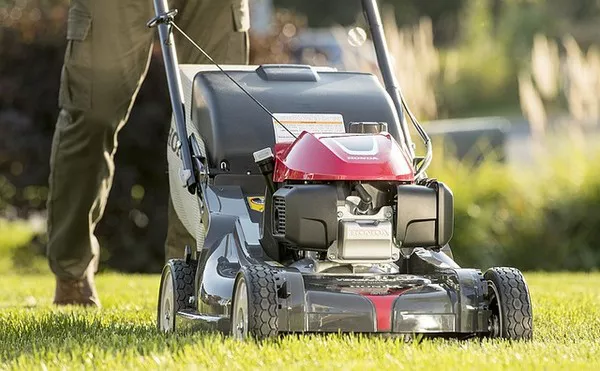Lawn mowers are an essential tool for maintaining a well-kept and manicured lawn. They come in various types, but one of the most common and widely used designs is the 4-stroke lawn mower. In this article, we will explore what a 4-stroke lawn mower is, how it works, its advantages, and its maintenance requirements.
What is a 4-Stroke Lawn Mower?
A 4-stroke lawn mower, often simply referred to as a “four-stroke mower,” is a gas-powered machine used for cutting grass and maintaining lawns. The term “4-stroke” refers to the engine design and operation, which involves four distinct phases in the internal combustion process. These phases are:
Intake: Air and fuel are drawn into the engine’s cylinder as the intake valve opens.
Compression: The piston compresses the air-fuel mixture, preparing it for ignition.
Combustion: A spark plug ignites the compressed mixture, leading to an explosion and the release of energy that drives the engine.
Exhaust: The exhaust valve opens, allowing the burnt gases to exit the cylinder.
The four-stroke engine design is known for its efficiency and low emissions, making it a preferred choice for many lawn mowers.
How Does a 4-Stroke Lawn Mower Work?
Understanding the operation of a 4-stroke lawn mower engine is vital for both users and maintainers. Here’s a step-by-step explanation of how it works:
Intake: As the engine starts, the intake valve opens, allowing a mixture of air and fuel to enter the cylinder. The carburetor regulates the fuel-air mixture, ensuring the proper ratio for combustion.
Compression: The piston moves upward, compressing the air-fuel mixture. This compression significantly increases the efficiency and power output of the engine.
Combustion: Once the air-fuel mixture is compressed, a spark plug ignites it. This ignition generates a controlled explosion, causing the piston to move downward with considerable force. This is the power stroke, responsible for turning the mower’s blades and propelling it forward.
Exhaust: After the power stroke, the exhaust valve opens, and the burnt gases exit the cylinder. This prepares the cylinder for the next intake phase.
The four-stroke cycle repeats continuously as long as the engine is running, allowing the lawn mower to function smoothly and efficiently.
Advantages of 4-Stroke Lawn Mowers
4-stroke lawn mowers offer several advantages that make them a popular choice for homeowners and professional landscapers:
Fuel Efficiency: Four-stroke engines are known for their fuel efficiency. They consume less fuel compared to two-stroke counterparts, making them cost-effective in the long run.
Low Emissions: These engines produce fewer emissions, which is better for the environment and complies with stricter emissions regulations.
Smooth Operation: Four-stroke engines operate more smoothly and produce less noise and vibration, creating a more pleasant mowing experience.
Durability: They tend to have longer lifespans and require fewer repairs compared to two-stroke engines.
Better Torque: The torque output of a 4-stroke engine is generally higher, allowing for more effective grass cutting, especially in tall or thick grass.
Reduced Maintenance: These engines typically have fewer moving parts and require less maintenance compared to two-stroke engines.
Maintenance Tips for 4-Stroke Lawn Mowers
To keep your 4-stroke lawn mower in top condition, regular maintenance is crucial. Here are some essential maintenance tips:
Regular Oil Changes: Change the engine oil as per the manufacturer’s recommendations. Clean oil ensures proper lubrication and prevents overheating.
Air Filter Maintenance: Clean or replace the air filter regularly to maintain the engine’s efficiency. A dirty air filter can reduce performance and increase fuel consumption.
Spark Plug Replacement: Change the spark plug according to the manufacturer’s schedule to ensure a consistent and efficient ignition.
Check the Fuel System: Inspect the fuel system for leaks, and use fresh, clean gasoline to prevent clogs in the carburetor.
Keep Blades Sharp: Dull blades can damage your lawn and put extra strain on the engine. Sharpen the blades at the beginning of each mowing season.
Maintain the Mower Deck: Clean the underside of the deck to prevent grass buildup, which can lead to rust and reduced cutting efficiency.
Inspect the Ignition System: Check the ignition system for loose or damaged wires, ensuring reliable spark for ignition.
Store Properly: When not in use, store your lawn mower in a dry, cool place. Remove the spark plug and drain the fuel if storing for an extended period.
Handle the Fuel Carefully: Use fresh fuel and consider using fuel stabilizers if you anticipate storing the mower for an extended period.
Read the Manual: Always refer to your mower’s manual for specific maintenance instructions and schedules.
Troubleshooting Common Issues
Even with regular maintenance, you may encounter some common issues with your 4-stroke lawn mower. Here’s how to troubleshoot them:
Starting Problems: If your mower won’t start, check the spark plug, fuel, and carburetor for issues. Make sure the choke is set correctly and the air filter is clean.
Loss of Power: If the mower lacks power, inspect the air filter, spark plug, and fuel system. Dull blades or a clogged deck can also cause this issue.
Excessive Vibration: Excessive vibration may indicate unbalanced blades or a bent crankshaft. Inspect the blades and replace any damaged components.
Engine Overheating: Overheating can be caused by low oil levels or a dirty air filter. Ensure proper oil levels and clean or replace the air filter.
Uneven Cutting: If the mower leaves patches of uncut grass, check the blade’s sharpness and balance. Adjust the deck height and ensure the mower is on level ground.
Conclusion
A 4-stroke lawn mower is a reliable and efficient tool for maintaining a well-groomed lawn. Understanding its operation, advantages, and proper maintenance procedures is essential for keeping your mower in top condition. By following these guidelines, you can enjoy a beautifully manicured lawn for years to come.

